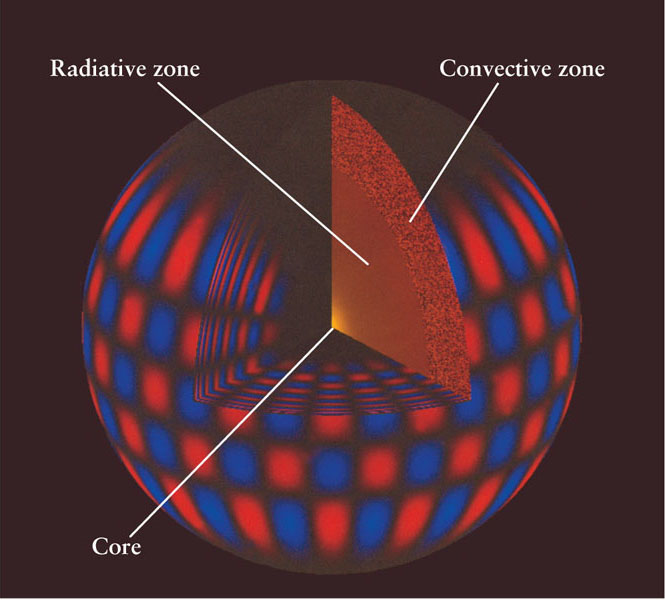16-3 Astronomers probe the solar interior using the Sun’s own vibration
We have described how astrophysicists construct models of the Sun. But since we cannot see into the Sun’s opaque interior, how can we check these models to see if they are accurate? What is needed is a technique for probing the Sun’s interior. A very powerful technique of just this kind involves measuring vibrations of the Sun as a whole. This field of solar research is called helioseismology.
Vibrations are a useful tool for examining the hidden interiors of all kinds of objects. Food shoppers test whether melons are ripe by tapping on them and listening to the sound made by the resulting vibrations. Since the vibrations of a melon depend on its density profile, the sounds from tapping provide clues about the melon’s interior. Similarly, geologists can determine the structure of Earth’s interior by using seismographs to record vibrations during earthquakes.
Although there are no true “sunquakes,” the Sun does vibrate at a variety of frequencies, somewhat like a ringing bell. These vibrations were first noticed in 1960 by Robert Leighton of the California Institute of Technology, who made high-precision Doppler shift observations of the solar surface. These measurements revealed that parts of the Sun’s surface move up and down about 10 m every 5 minutes. Since the mid-1970s, several astronomers have reported slower vibrations, having periods ranging from 20 to 160 minutes. The detection of extremely slow vibrations has inspired astronomers to organize networks of telescopes around and in orbit above Earth to monitor the Sun’s vibrations on a continuous basis.
The vibrations of the Sun’s surface can be compared with sound waves. If you could somehow survive within the Sun’s outermost layers, you would first notice a deafening roar, somewhat like a jet engine, produced by turbulence in the Sun’s gases. But superimposed on this noise would be a variety of nearly pure tones. You would need greatly enhanced hearing to detect these tones, however; the strongest has a frequency of just 0.003 hertz, 13 octaves below the lowest frequency audible to humans. (Recall from Section 5-2 that one hertz is one oscillation per second.)
In 1970, Roger Ulrich, at UCLA, pointed out that sound waves moving upward from the solar interior would be reflected back inward after reaching the solar surface. However, as a reflected sound wave descends back into the Sun, the increasing density and pressure bend the wave severely, turning it around and aiming it back toward the solar surface. In other words, sound waves bounce back and forth between the solar surface and layers deep within the Sun. These sound waves can reinforce each other if their wavelength is the right size, just as sound waves of a particular wavelength resonate inside an organ pipe.
The Sun’s oscillations resemble those inside an organ pipe but are much more complex
The Sun oscillates in millions of ways as a result of waves resonating in its interior. Figure 16-5 is a computer-generated illustration of one such mode of vibration. Helioseismologists can deduce information about the solar interior from measurements of these oscillations. In addition to providing information about interior temperatures and densities, helioseismology sets limits on the amount of helium in the Sun’s core and convective zone and determines the thickness of the transition region between the radiative zone and convective zone.

443
CONCEPT CHECK 16-8
Do solar sound waves travel exclusively on the surface of the Sun—like ripples across a pond—or do they travel through the Sun’s interior as well?
CONCEPT CHECK 16-9
What can be determined from carefully monitoring the Sun’s vibrations?